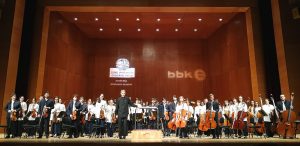Concert of the EGO in Bilbao with music by Rimsky-Korsakov and Leonard Bernstein
Last Thursday, July 20th, a concert was held at the Euskalduna Palace in Bilbao by the Euskal Herriko Gazte Orkestra – EGO (Young Orchestra of the Basque Country), with a mixed program that included the wonderful classic piece Scheherazade by Nikolai Rimsky-Korsakov and the orchestral adaptation of the music from West Side Story by Leonard Bernstein through the “Symphonic Dances of West Side Story“.
This concert was part of a concert tour that the Euskal Herriko Gazte Orkestra – EGO (Young Orchestra of the Basque Country) conducted in Hondarribia, Donostia-San Sebastián, Bilbao and Vitoria-Gasteiz (north of Spain) that same week.
The performance in Bilbao began at 8:00 pm, and after the young band members occupied the stage, its director Juan Jose Ocon, raised the baton and started the first movement of the four that compose Scheherazade: “The Sea and Sinbad’s Ship”.
From the beginning it was possible to observe the agility, precision and compromise in the sweet and exotic sounds of the young concertmistress of the orchestra, carrying the weight of most of the pieces on the first part of the concert. The music of the strings came and went in this first movement, as if some sound waves were whipping the audience, filling the space available in the hall with a wonderful interpretation of the whole orchestra.
The second movement, “The Kalandar Prince”, started smoothly with the inclusion of complementary sounds to the strings by the wind-wood the section, which provided a suitable counterpoint, that were subtly and introductively accompanied the harp.
A polished and lucid sound of the violin gave way to the third movement “The Young Prince and The Young Princess” where the sweet love story was perfectly reflected in the music, before moving to the ending in the fourth movement. With “Festival at Baghdad. The Sea. The Ship Breaks against a Cliff Surmounted by a Bronze Horseman”, a committed orchestra took us back into the frenetic conclusion of the story, with a brass section stressing the importance of the action, but leaving space for a last violin solo, which closed with calm and serenity the piece in a new impressive performance of the concertmistress, corresponded by a great applause of the audience.
When it seemed that the concert was going to be performed without intermission, there was a short pause at 9 pm, to continue with the second part 10 minutes later. The orchestra returned to take their seats but with a slight modification, the concertmistress changed place with her partner on the left, receiving a well-deserved rest after the work done in the first part.
The second part was dedicated to the “Symphonic Dances of West Side Story” that originated as a concert adapted version that composer Leonard Bernstein made back in 1961, following the success that West Side Story gained both with the musical in 1957 and with the film in 1961.
With a total of 9 movements stretching over 24 minutes, the orchestra gave us a mixture and fusion of musical styles like jazz, cha-cha-cha, rumba, salsa and other Latin rhythms, but with the color palette that only a symphony orchestra can provide. A very interesting, cheerful, and fun counterpoint to the program, which had a precise interpretation of the orchestra very well coordinated by its director Juan Jose Ocon.
At the end of the concert the audience applauded with enthusiasm and emotion, making the orchestra go on with an encore, the “Mambo” movement of the Symphonic Dances of West Side Story; funny and cheerful, that was used to make a casual presentation of the various sections of the orchestra as a farewell.
And so, when it was past 9:40 pm, a great concert ended, with a young orchestra that showed that the musical quality is not incompatible with age, but is closely tied to the desire and hours of practice. A night filled by young musicians, who had nothing to envy in their interpretation to veteran and more established orchestras.













